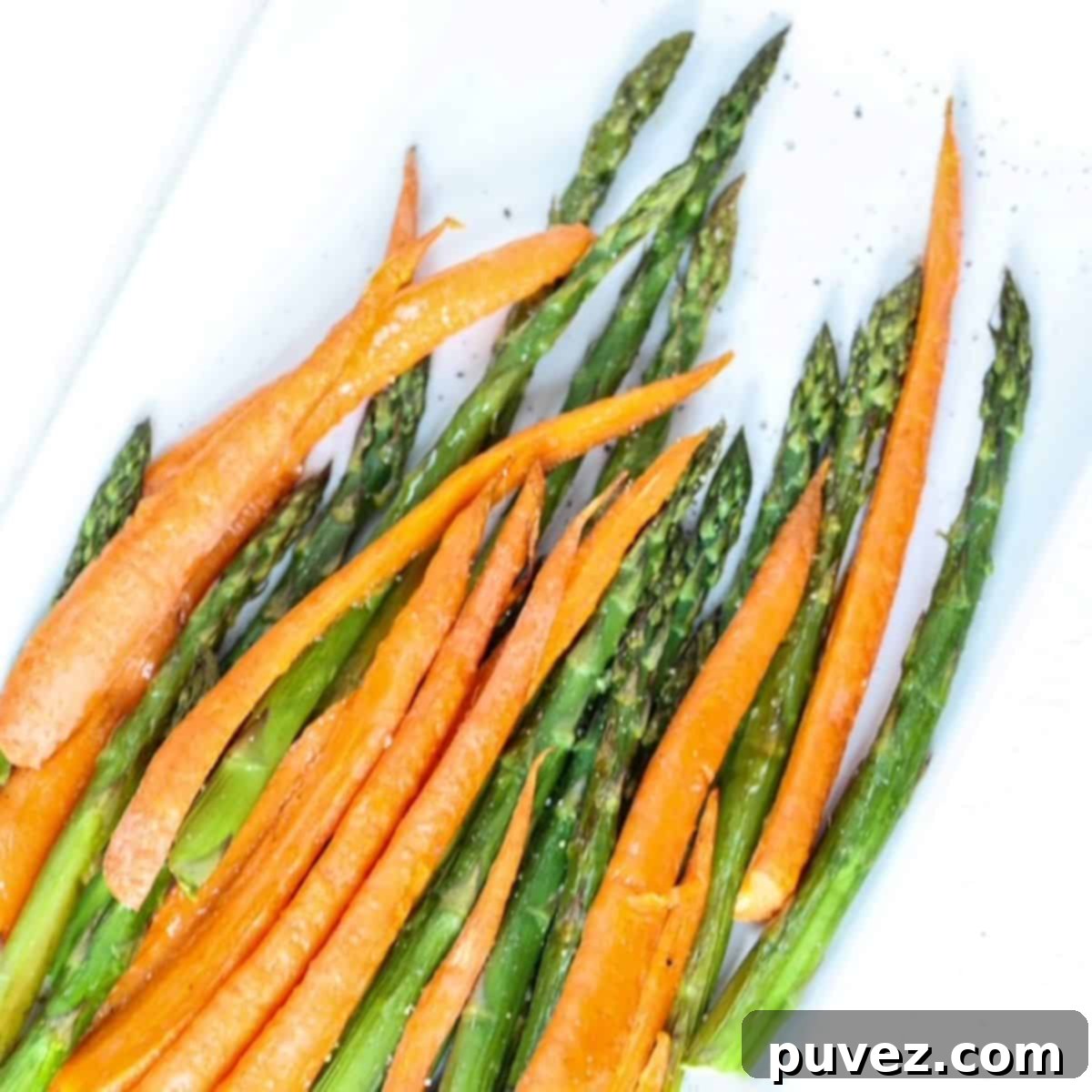Easy Roasted Asparagus and Carrots: A Simple, Healthy & Delicious Side Dish
Discover the ultimate effortless side dish with these incredibly easy **Roasted Asparagus and Carrots**! Made with vibrant fresh asparagus, naturally sweet carrots, and just a few simple seasonings, this recipe comes together in a mere 15-20 minutes. It’s the perfect healthy addition to any weeknight meal, offering a burst of color and nutrition that the whole family will love.
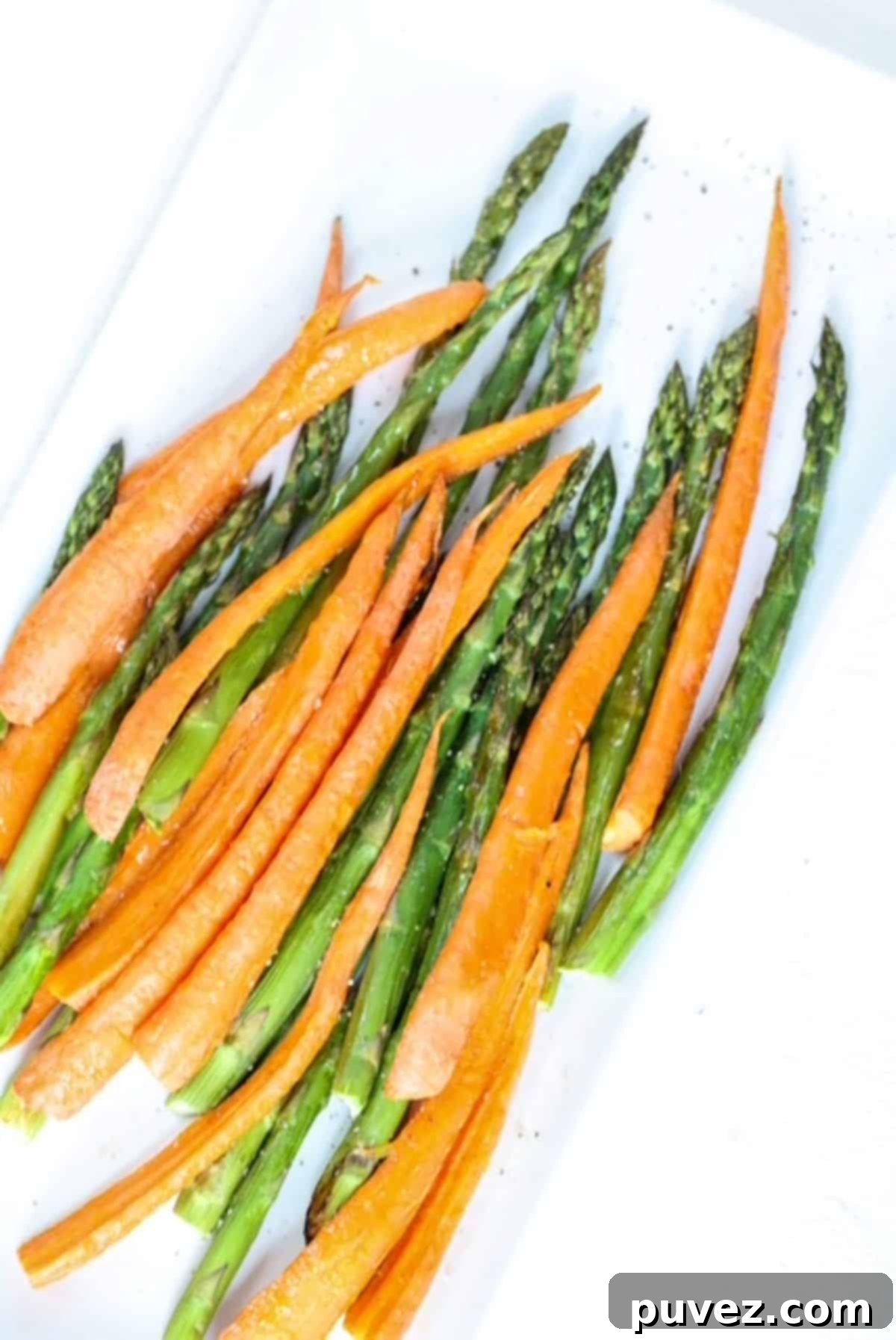
This classic recipe has been thoughtfully updated to include the delightful addition of sweet carrots, enhancing both the variety and depth of flavor! What started as a beloved roasted asparagus recipe has evolved into a powerhouse combination of roasted asparagus AND carrots, offering even more reasons to celebrate seasonal vegetables. 🙌
When spring arrives, nothing quite signals its freshness like the appearance of tender asparagus. While many opt for blanching, I wholeheartedly recommend roasting. Why? Because it’s incredibly simple, requires minimal effort, and yields unbelievably delicious results every time. Roasting brings out the natural sweetness of vegetables, creating a slightly caramelized exterior and a tender interior that’s hard to resist.
The magic truly happens when you pair asparagus with another fantastic vegetable like carrots. This combination doesn’t just add more vibrant color to your plate; it significantly boosts the nutritional value of your meal. Carrots provide a lovely sweetness and a different texture that complements the distinct flavor of asparagus, making each bite an interesting experience.
For seasoning, I believe in keeping it simple to let the natural flavors of these spring vegetables shine. A drizzle of quality olive oil, a sprinkle of salt, and a dash of black pepper are often all you need for perfection. However, for those who love to experiment, feel free to elevate the dish with fresh herbs like dill or parsley, a hint of zesty lemon, or a dusting of grated Parmesan cheese for an extra layer of savory flavor. The beauty of this recipe lies in its adaptability – customize it to your heart’s content!
Why You’ll Fall in Love with This Easy Recipe
- Effortlessly Easy & Delicious: This recipe is a game-changer for anyone seeking a healthy side dish without the fuss. It’s incredibly simple to prepare, making it ideal for busy weeknights when time is of the essence. In just 15-20 minutes, you can have a flavorful and nutritious vegetable side ready to serve. Its versatility means it pairs wonderfully with a wide array of main courses, including succulent Lemon Pepper Chicken, savory Baked Pork Chops, or hearty Italian Baked Chicken. It’s also a fantastic companion for grilled fish, steak, or even a simple pasta dish.
- Simple, Wholesome Ingredients: You’ll only need a handful of fresh, readily available ingredients: crisp asparagus spears, sweet carrots, good quality extra virgin olive oil, and basic salt and black pepper. All these can be easily found in the produce section of your local grocery store. The beauty of this recipe lies in how these simple components combine to create a deeply satisfying flavor profile. Choosing fresh, seasonal vegetables ensures the best taste and nutritional benefits.
- Excellent for Meal Prep & Leftover Versatility: Roasting is arguably one of the quickest and most effective methods for preparing vegetables, especially if you’re into meal prepping for the week or need to get dinner on the table in a flash. Not only do roasted vegetables taste fantastic fresh, but leftovers are also incredibly versatile. Transform them into delicious additions for morning omelets, vibrant grain bowls, quick stir-fries, refreshing salads, or comforting soups. Preparing a larger batch means you’ll have healthy veggies ready to enhance multiple meals throughout the week, saving you time and effort.
Dietitian’s Insight: Nurturing Healthy Eating Habits
- Introducing New Foods with Confidence: For both children and adults, serving a less familiar vegetable alongside a beloved, familiar one is a highly effective strategy for encouraging new food acceptance. The comfort of the known can reduce apprehension towards the unknown. In this recipe, the inherent sweetness and familiar crunch of carrots can make the distinctive taste and texture of asparagus more approachable, especially for picky eaters. This gentle introduction helps expand palates over time without overwhelming them.
- Embracing Simplicity for Broader Appeal: Children’s taste buds, and often those of many adults, tend to be more sensitive to strong or complex flavors. Keeping the seasoning simple – just a touch of olive oil, salt, and pepper – not only saves valuable preparation time but also significantly increases the likelihood of acceptance. This minimalist approach allows the natural, delicious flavors of the vegetables to shine through, preventing any overwhelming sensations. Furthermore, it leaves ample room for creativity for those who prefer more adventurous flavors. You can offer optional add-ons at the table, such as a squeeze of lemon, a sprinkle of fresh herbs, or a dash of Parmesan, empowering individuals to customize their meal to their personal preference. This fosters a positive relationship with food and encourages adventurous eating on their own terms.
Ingredient Spotlight: What You Need to Know
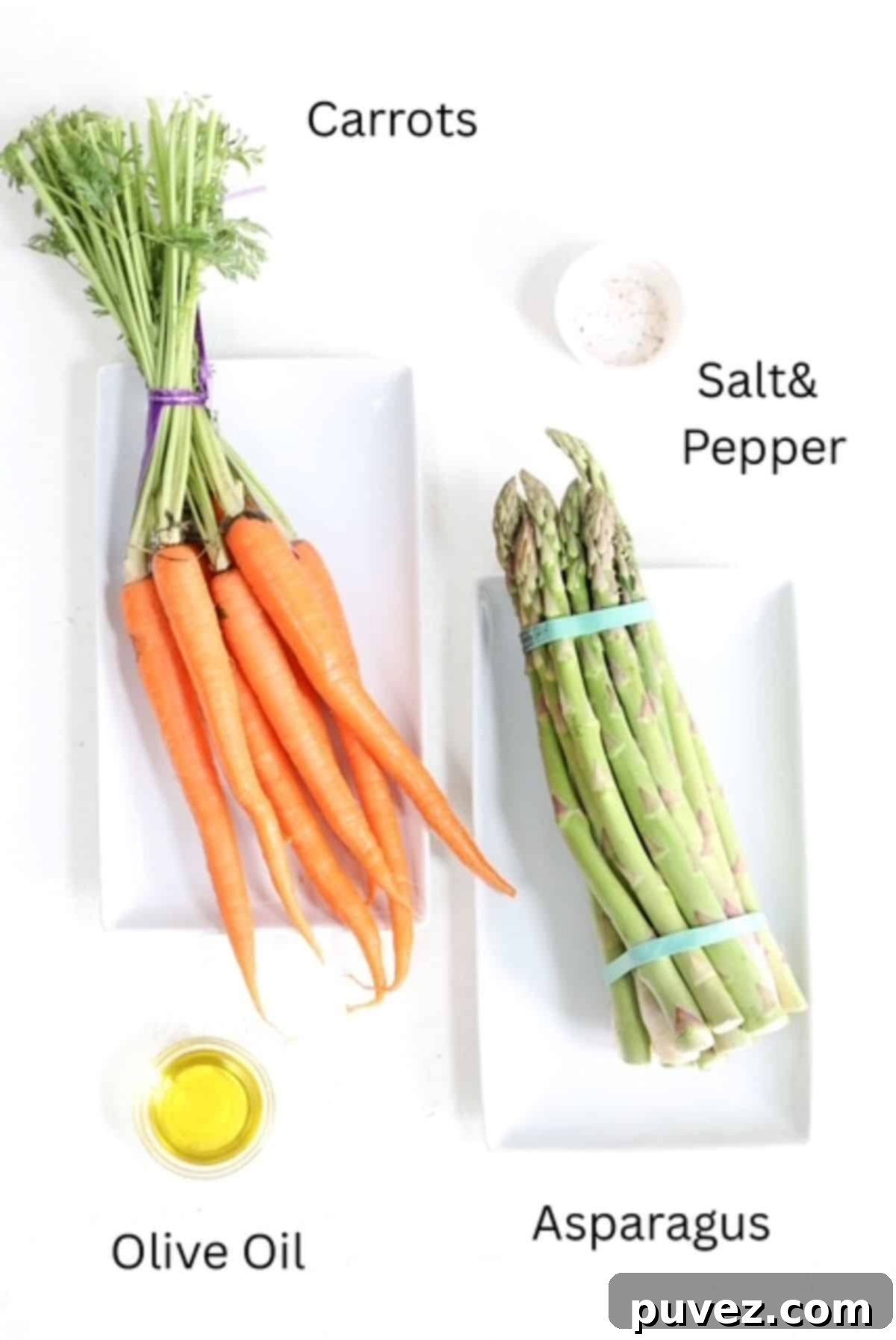
- Asparagus: For optimal results, always opt for fresh asparagus spears over frozen. Fresh asparagus roasts beautifully, maintaining its crisp-tender texture and vibrant green color. When selecting, look for firm, bright green stalks with tightly closed tips. If possible, choose thicker asparagus spears. These tend to be more tender and less fibrous than very thin ones, and crucially, they’ll have a more similar cooking time to carrots, ensuring everything is perfectly cooked simultaneously. Asparagus is a nutritional powerhouse, packed with essential vitamins and minerals, including a good source of dietary fiber, which aids digestion. It’s also recognized for its prebiotic properties, supporting a healthy gut microbiome, and rich in folate and Vitamins A, C, and K.
- Carrots: Regular, medium-sized carrots are ideal for this recipe. Their natural sweetness intensifies beautifully when roasted, adding a lovely counterpoint to the earthy notes of asparagus. Ensure they are firm and free from blemishes. Carrots are an excellent source of fiber, carotenoids (like beta-carotene, which converts to Vitamin A in the body), anthocyanins, and a host of other vital nutrients. These compounds are powerful antioxidants, contributing to overall health, vision, and skin vitality.
- Extra Virgin Olive Oil: This is my preferred choice due to its delightful flavor and numerous health benefits. Extra virgin olive oil is rich in heart-healthy monounsaturated fats, which can help lower bad cholesterol levels. Its robust flavor also adds a wonderful depth to the roasted vegetables. If you prefer a more neutral taste or have dietary restrictions, avocado oil, grapeseed oil, or a light olive oil can be used as alternatives. Ensure you use just enough to lightly coat the vegetables without drenching them, to prevent steaming instead of roasting.
- Salt and Black Pepper: These basic seasonings are all you truly need to enhance the natural flavors of the vegetables. Use a good quality sea salt or kosher salt, and freshly ground black pepper for the best taste. Adjust amounts to your personal preference.
How to Make Perfectly Roasted Asparagus and Carrots
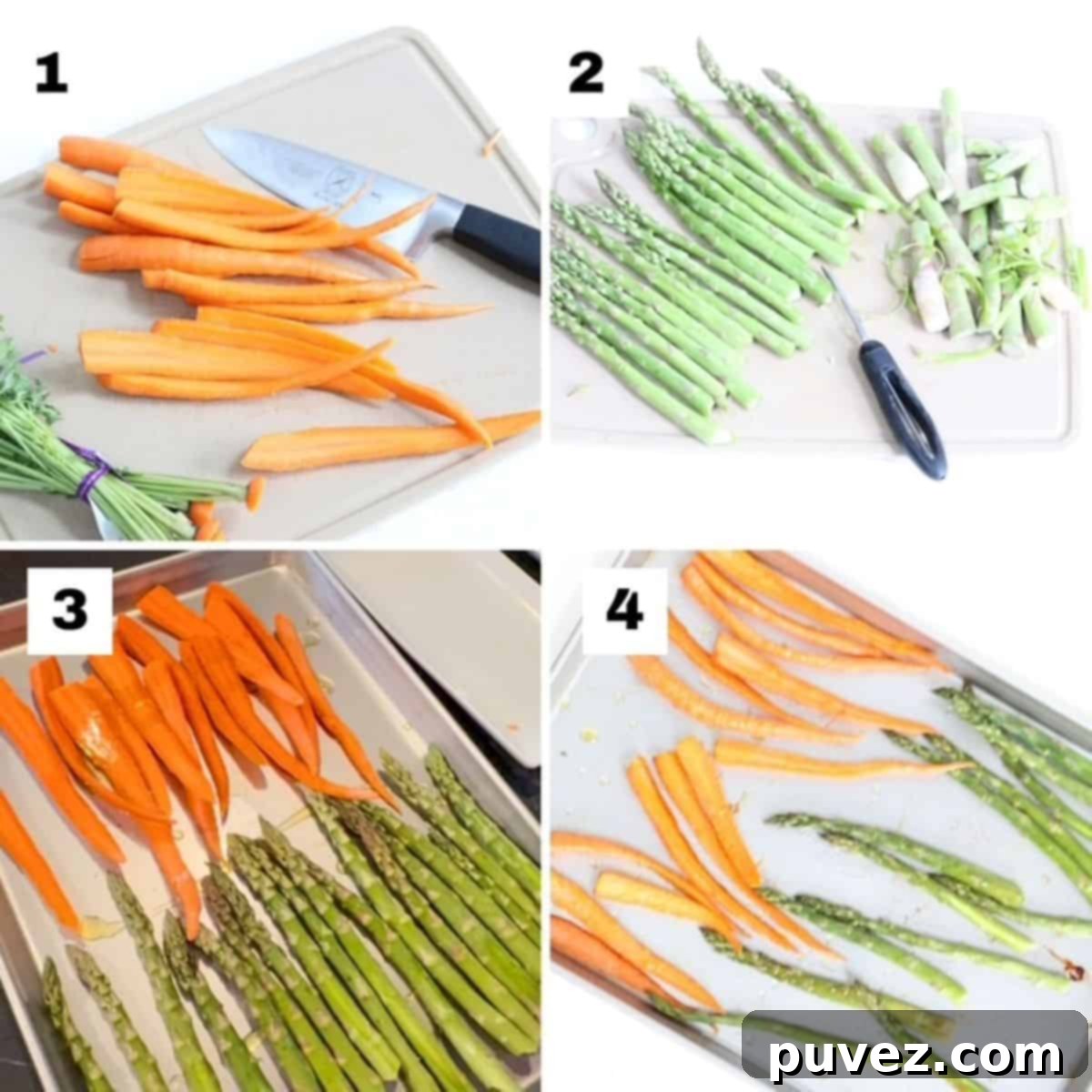
Crafting this flavorful side dish is incredibly straightforward. Here’s a quick, step-by-step overview of how to achieve perfectly roasted asparagus and carrots. For a comprehensive list of ingredients and detailed instructions, please refer to the complete recipe card located at the bottom of this post.
- Prepare the Vegetables: Begin by washing your asparagus and carrots thoroughly. Using a chef’s knife and a sturdy cutting board, carefully remove the leafy tops from the carrots and trim off the tough, woody ends from each asparagus spear. A good tip for asparagus is to gently snap the spear; it will naturally break where the tough part ends.
- Slice the Carrots: To ensure even cooking with the asparagus, slice each carrot in half lengthwise. For larger carrots, you might even quarter them. The goal is to create pieces roughly similar in thickness to your asparagus spears. This uniformity is key to preventing some vegetables from overcooking while others remain undercooked.
- Arrange and Season: Lay the prepped asparagus spears and carrot strips in a single layer on a large baking sheet. Ensure they are spread out and not overlapping; overcrowding the pan can lead to steaming instead of roasting. Drizzle them generously with extra virgin olive oil, then sprinkle evenly with a pinch of salt and a grind of fresh black pepper. Toss gently with your hands or tongs to ensure every piece is lightly coated.
- Roast to Perfection: Place the baking sheet into a preheated oven set to 400 degrees Fahrenheit (200°C). Roast for 15-20 minutes. The vegetables are done when they are tender-crisp, slightly caramelized at the edges, and can be easily pierced with a fork. Keep an eye on them, as cooking times can vary based on the thickness of your vegetables and your oven’s calibration.
Helpful Tips for the Best Roasted Veggies
- Asparagus Terminology: Don’t get confused! “Asparagus stalks” and “asparagus spears” refer to the exact same thing. These words can be used interchangeably, so use whichever term feels most natural to you.
- Effortless Cleanup: For a quick and easy post-dinner cleanup, always line your baking sheet with parchment paper or aluminum foil. This prevents the vegetables from sticking to the pan and makes washing up a breeze.
- Preventing Chewy Asparagus: While snapping the woody ends is common, an alternative method for thicker spears is to peel some of the tougher, fibrous outer layer from the bottom 1-2 inches of each asparagus stalk with a vegetable peeler. This softens the thicker part of the stalk, ensuring a consistently tender bite throughout and preventing any chewy surprises.
- The Right Amount of Oil and Salt: Be mindful not to add too much olive oil or salt. Excess oil can cause the vegetables to steam rather than roast, resulting in a wet and soggy texture instead of the desired crisp-tender finish. Similarly, too much salt can draw out excessive moisture, impacting the texture. A light, even coating is key.
- Uniform Cutting for Even Cooking: For the best results, ensure your carrots are cut into pieces that are roughly the same size and thickness as your asparagus stalks. This ensures they cook evenly and are perfectly tender at the same time. If some pieces are significantly thicker, they may require more cooking time, or vice-versa.
- Adjusting Cooking Time: Remember that cooking time is not set in stone and will vary depending on the thickness of your asparagus stalks and carrot pieces, as well as the calibration of your oven. Thinner asparagus stalks, for instance, will cook in less time (around 10-12 minutes) than their thicker counterparts. Always test for doneness by piercing with a fork.
- Using Baby Carrots: If you opt for baby carrots instead of regular-sized ones, they will also need some preparation. For standard baby carrots, slice them in half lengthwise before placing them on the baking sheet to ensure they cook evenly. If you’re using ‘petite’ baby carrots (the tiny ones), you can usually roast them whole, as their small size allows for quick and even cooking.
- Storing Leftovers: Once cooled completely to room temperature, store any leftover roasted asparagus and carrots in an airtight container in the refrigerator for up to 3 days. Reheat gently in the oven or a skillet to maintain some of their crispness, or enjoy them cold in salads.
- Flavor Variations: Feel free to experiment! A squeeze of fresh lemon juice after roasting brightens the flavors. A sprinkle of garlic powder or a few minced garlic cloves added with the oil enhances the savory notes. For a cheesy touch, add grated Parmesan in the last few minutes of roasting.
Frequently Asked Questions About Roasting Veggies
Asparagus can become mushy primarily due to two reasons: overcooking or excessive moisture. When left in the oven for too long, asparagus loses its desirable crisp-tender texture and becomes soft. Additionally, if the asparagus is wet when placed on the baking sheet, the residual water will create a steaming effect in the hot oven. Steaming softens the asparagus, leading to a mushy result. To prevent this, always ensure your asparagus is thoroughly dried after washing before you toss it with oil and place it in the oven.
Absolutely, yes. It’s crucial to always wash fresh asparagus (and all produce) before cooking to remove any dirt, pesticides, or other residues. After washing, it is equally important to pat the asparagus completely dry with a clean kitchen towel or paper towels. This step is vital to ensure proper roasting and to avoid the mushy texture caused by excess moisture, as mentioned above. Whether you plan to store it or roast it immediately, washing and drying are key.
While simple salt and pepper are often sufficient, there are many easy ways to enhance the flavor of roasted vegetables. Consider adding finely chopped fresh herbs like parsley, dill, thyme, or rosemary directly to the vegetables before roasting. For a bright, zesty kick, a sprinkle of fresh lemon zest (or a squeeze of lemon juice after roasting) works wonders. Another fantastic option is to toss the vegetables with grated Parmesan cheese during the last few minutes of roasting for a savory, umami boost. A dash of garlic powder or onion powder can also deepen the flavor profile without much effort.
For the best texture and flavor, it is highly recommended to use fresh asparagus and carrots for roasting. Frozen vegetables tend to release a lot of water as they cook, which can lead to a steamed, soggy result rather than a beautifully roasted and caramelized one. If you must use frozen, do not thaw them first. Roast them directly from frozen and be aware that they might take longer to cook and won’t achieve the same crisp-tender texture as fresh produce.
Achieving extra crispy roasted vegetables depends on a few factors. First, ensure your vegetables are completely dry after washing. Second, do not overcrowd the baking sheet; leave enough space between the vegetables for hot air to circulate, which promotes browning and crisping. If your pan is too full, use two sheets. Third, a slightly higher oven temperature (like 425°F/220°C for a shorter duration, if comfortable) can promote crisping. Finally, ensure a light, even coating of oil, as too much oil can lead to a greasy rather than crispy texture.
Explore More Delicious Roasted Vegetable Recipes
If you loved this simple and healthy roasted vegetable dish, you’ll surely enjoy these other fantastic recipes that celebrate the power of oven-roasted goodness:
- Oven Roasted Brussels Sprouts: Crispy on the outside, tender on the inside – a classic side dish reinvented.
- Roasted Beets in Foil: Earthy and sweet, roasted beets are incredibly easy to prepare in foil packets.
- Roasted Root Vegetables: A colorful medley of hearty root vegetables, perfect for a comforting meal.
- Roasted Broccoli (Air Fryer): Quick and perfectly cooked broccoli with a cheesy twist, made even faster in an air fryer.
Discover More Easy & Flavorful Side Dishes
Looking for more simple yet delicious accompaniments to your meals? These easy side dish recipes are perfect for adding variety and flavor to any plate:
- Easy Roasted Peaches
- Simple Lemon Garlic Salad Dressing
- Apple Cider Vinaigrette Dressing
- Easy Deviled Eggs Without Mustard
Did you make this roasted asparagus and carrots recipe and absolutely love it? Please consider leaving a ⭐⭐⭐⭐⭐ star rating and a thoughtful review in the comments section below to let me know! Your 5-star rating is truly the best compliment and helps others discover this recipe.
And for more inspiring meal ideas, nutrition tips, and a peek into my kitchen, don’t forget to follow me @carrots.and.cookies on Instagram!
📖 Recipe
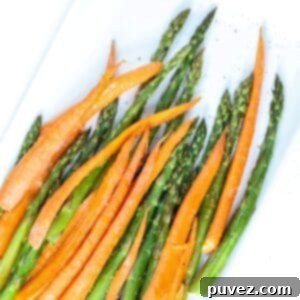
Roasted Asparagus and Carrots
Kristi
Pin Recipe
Equipment
-
1 Sheet pan
-
1 chefs knife
-
1 veggie peeler optional
-
1 Cutting board
Ingredients
- 1 pound fresh asparagus Preferably thicker stalks of asparagus. Washed well.
- 6 carrots Small to medium sized. Washed well and both ends removed.
- 1 tablespoon olive oil extra virgin
-
pinches of salt
or to taste (start with 1-2 pinches)
-
pinch of pepper
optional, or to taste
Instructions
-
Preheat your oven to 400° Fahrenheit (200°C) to ensure it’s hot and ready for roasting.
-
Prepare the asparagus: Wash the asparagus well and pat dry. Carefully remove the tough, woody part of each asparagus stalk (typically the bottom one to one-and-a-half inches). You can do this by gently snapping each spear or by trimming it with a knife. For thicker spears, use a vegetable peeler to peel a few thin strips off the very ends of each asparagus stalk to ensure consistent tenderness.
-
Prepare the carrots: Wash the carrots well, remove both ends, and peel if desired. Depending on the size of the carrots, use a chef’s knife to slice them in half lengthwise. For very thick carrots, you may want to quarter them to create pieces roughly similar in size to the asparagus stalks for even cooking.
-
Arrange the vegetables: Lay the prepared asparagus stalks and carrot slices out on a large baking sheet in a single, even layer. It’s important they are spread out and not overlapping, to allow them to roast and slightly caramelize rather than steam. If necessary, use two baking sheets to avoid overcrowding.
-
Season the veggies: Drizzle the vegetables with a light coating of extra virgin olive oil. Start with a tablespoon, and add more if needed, ensuring a light coating without drenching. Sprinkle generously with a pinch or two of salt and fresh black pepper. Toss everything gently with your hands or tongs to coat evenly.
-
Distribute oil evenly: If you’d like, use tongs to shift the stalks slightly over the oil, or use a small basting brush to spread the oil as evenly as possible over most of each stalk and carrot piece. This helps ensure even browning.
-
Roast: Place the baking sheet in the preheated oven and roast for 15-20 minutes. The exact cooking time will depend on the thickness of your asparagus stalks and carrot pieces, as well as your oven. The vegetables are perfectly done when they are tender-crisp and can be easily pierced with a fork, with some nice caramelization on the edges. Start checking them at 15 minutes. If you’re roasting very thin asparagus stalks and smaller carrot pieces, begin checking on them after 10-12 minutes to prevent overcooking.
-
Serve: Once roasted to your liking, remove from the oven and serve immediately while hot and delicious!
Notes
- Avoid Soggy Veggies: To achieve crisp-tender results, be careful not to overdo it with oil or salt. Adding too much oil can cause the asparagus and carrots to steam rather than roast, leading to a wet and mushy texture.
- Fresh is Best: Always use fresh asparagus, not canned or frozen. Fresh spears roast beautifully and maintain their ideal texture.
- Monitor Cooking Time: Cooking time is variable and largely depends on the thickness of your asparagus stalks and carrot pieces. Very thin asparagus spears might be done in as little as 10-12 minutes, so start checking early.
- Oil Quantity Guidance: As a general guideline, you can estimate using about ½ to 1 teaspoon of olive oil per ten spears of asparagus or carrot pieces. The goal is a light, even coating.
- Easy Clean-Up Trick: For a hassle-free cleanup, always line your baking sheet with parchment paper or foil before arranging the asparagus and carrots in a single layer.
- Uniformity for Evenness: For optimal and even cooking, ensure your carrots are cut to a size and thickness that is similar to your asparagus stalks.
- Baby Carrot Prep: If you’re using standard baby carrots, slice them in half lengthwise before roasting. If you have ‘petite’ baby carrots (the very tiny ones), they can typically be roasted whole.
- Flavor Boost: Feel free to add a squeeze of fresh lemon juice, a sprinkle of garlic powder, or some chopped fresh herbs like dill or parsley after roasting for an extra burst of flavor.
Nutrition
